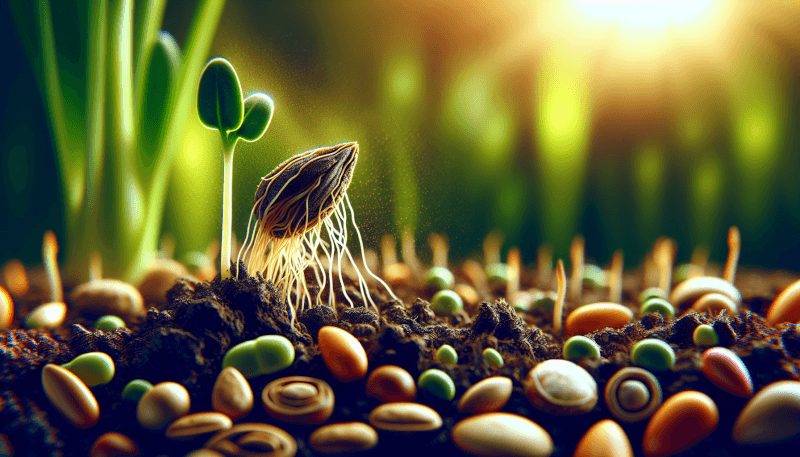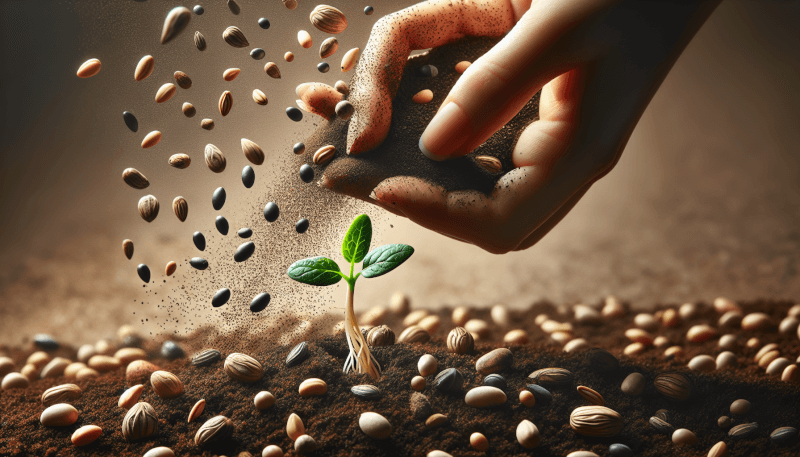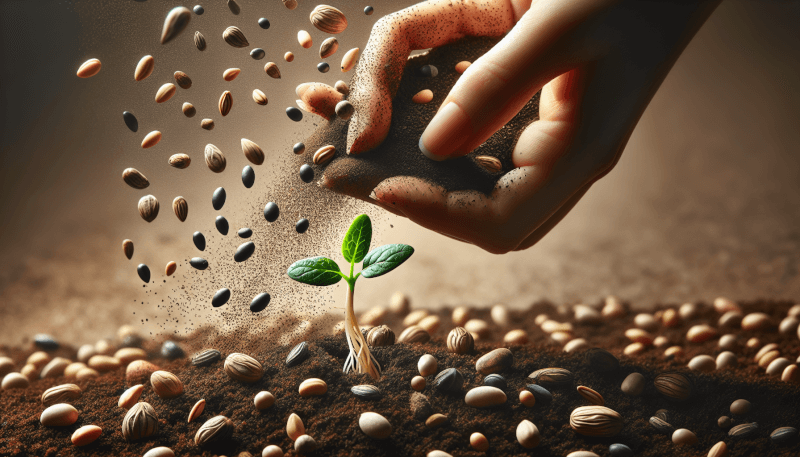In the world of sprouting, choosing the right seeds is essential for achieving optimal results. Whether you’re a seasoned sprouter or just starting out, this ultimate guide will walk you through the process of selecting the best seeds for sprouting. From understanding the different types of seeds to considering factors like taste, texture, and nutritional value, this comprehensive article will provide you with all the information you need to embark on your sprouting journey with confidence. So, grab a cup of tea, sit back, and get ready to learn everything there is to know about choosing the best seeds for sprouting!

Understanding Sprouting Seeds
What are sprouting seeds?
Sprouting seeds are seeds that have been soaked and germinated in water or moist conditions, allowing them to develop into young plants called sprouts. These sprouts can be consumed raw or used in various dishes, adding a fresh, crunchy texture and a burst of nutrients to meals.
Benefits of sprouting seeds
Sprouting seeds offer numerous benefits, making them a popular choice for health-conscious individuals. Firstly, sprouting seeds increase the bioavailability of certain nutrients, such as vitamins, minerals, and antioxidants. They are also easier to digest compared to unsprouted seeds, as some of the complex carbohydrates and proteins are broken down during the sprouting process. Sprouted seeds are also known to contain higher levels of enzymes, which can aid in digestion. Moreover, sprouting seeds can contribute to a well-balanced diet by providing essential amino acids, fatty acids, and fiber.
Common types of sprouting seeds
There is a wide variety of seeds that can be sprouted, each offering its own unique flavor and nutritional profile. Some common types of sprouting seeds include alfalfa, broccoli, mung bean, radish, clover, lentil, fenugreek, wheatgrass, quinoa, and chia. These seeds can easily be found in health food stores or online, allowing you to experiment with different flavors and textures.
Factors to Consider
Type of sprouts desired
Before getting started with sprouting, it’s important to consider the type of sprouts you want to grow. Different seeds produce different types of sprouts, ranging from mild and crunchy to bold and peppery. Understanding your preference for taste and texture will help you select the most suitable sprouting seeds.
Ease of growing
If you’re new to sprouting, it may be wise to start with seeds that are relatively easy to grow. Some seeds require more attention and a specific set of conditions to sprout successfully. Opting for beginner-friendly seeds will increase your chances of achieving successful sprouting results.
Germination rate
The germination rate refers to the percentage of seeds that successfully sprout. It’s important to choose seeds with a high germination rate to ensure a successful sprouting process. Read product descriptions and reviews to determine the germination rate before purchasing your sprouting seeds.
Nutritional value
Different sprouting seeds offer varying nutritional benefits. Consider the nutritional value of each seed, including the presence of vitamins, minerals, antioxidants, and beneficial plant compounds. This will help you make informed choices based on your dietary needs and health goals.
Taste and texture
Sprouts add flavor and texture to dishes, so it’s essential to choose seeds that align with your taste preferences. Some seeds have a mild taste, while others have a stronger, more distinct flavor. Additionally, the texture of sprouts can range from crisp and crunchy to tender and delicate. Consider what you enjoy and experiment with different seed varieties to find the perfect match.
Availability and cost
Consider the availability and cost of the sprouting seeds you’re interested in. Some seeds may be more readily available in your area or online, while others may be harder to find. Additionally, prices can vary, so it’s important to find a balance between quality and affordability.
Organic vs. non-organic
When selecting sprouting seeds, you may also want to consider whether you prefer organic or non-organic options. Organic seeds are grown without the use of synthetic pesticides or fertilizers, ensuring a more natural and sustainable sprouting experience. Non-organic seeds, on the other hand, may be more affordable but could potentially contain residues from chemical treatments.
Popular Types of Sprouting Seeds
Alfalfa
Alfalfa sprouts are one of the most common types of sprouts and are known for their mild, slightly nutty flavor. They are rich in vitamins A, C, and K and contain a range of minerals, including calcium and potassium. Alfalfa sprouts are a versatile addition to salads, sandwiches, or stir-fries.
Broccoli
Broccoli sprouts have gained popularity for their high concentration of sulforaphane, a compound known for its potential health benefits. These sprouts have a mild, slightly spicy taste and can be enjoyed in salads, smoothies, or as a topping for sandwiches and wraps.
Mung bean
Mung bean sprouts are a staple in Asian cuisine and are commonly used in stir-fries and noodle dishes. They have a crunchy texture and a slightly sweet taste. Mung bean sprouts are a good source of protein, fiber, and essential nutrients such as folate and manganese.
Radish
Radish sprouts add a delightful spicy kick to dishes with their peppery flavor. They are high in vitamins C and B6, as well as various minerals. Radish sprouts can be used to enhance the flavor of salads, sandwiches, and wraps.
Clover
Clover sprouts have a sweet, mild flavor and are packed with vitamins A, C, and E. They are also a good source of calcium, iron, and magnesium. Clover sprouts can be enjoyed in salads, sandwiches, or as a filling for wraps.
Lentil
Lentil sprouts are an excellent source of plant-based protein, fiber, and essential minerals such as iron and folate. They have a mildly nutty flavor and can be used in salads, soups, or as a topping for rice bowls and tacos.
Fenugreek
Fenugreek sprouts have a slightly bitter taste and are commonly used in Indian and Middle Eastern cuisines. They are a good source of iron, protein, and dietary fiber. Fenugreek sprouts can add a unique flavor to curries, stews, or grain-based dishes.
Wheatgrass
Wheatgrass sprouts are known for their vibrant green color and are often juiced and consumed for their high concentration of nutrients. They are rich in vitamins A, C, E, and a variety of minerals. Wheatgrass sprouts can be added to smoothies or used as a garnish for salads and soups.
Quinoa
Quinoa sprouts have a mild, nutty flavor and contain essential amino acids, making them a complete protein source. They are also high in dietary fiber, vitamins, and minerals. Quinoa sprouts can be used as a topping for grain bowls, salads, or added to stir-fries.
Chia
Chia sprouts are a lesser-known sprouting option but offer a unique nutritional profile. Chia seeds are known for their high omega-3 fatty acid content and are packed with fiber, protein, and antioxidants. Chia sprouts can be sprinkled on salads, yogurt, or used as a nutritious addition to baked goods.

Choosing High-Quality Seeds
Verified sources
When selecting sprouting seeds, it’s essential to choose seeds from verified and reputable sources. Look for companies or brands that have positive reviews and a history of providing high-quality sprouting seeds. This will ensure that you are starting with seeds that have a higher likelihood of success.
Certified organic
Choosing certified organic sprouting seeds can provide peace of mind, knowing that the seeds have been grown without the use of synthetic pesticides or genetically modified organisms (GMOs). Organic seeds are subjected to stricter regulations, ensuring a more natural and sustainable sprouting experience.
Non-GMO labels
If you prefer to avoid genetically modified organisms (GMOs), look for sprouting seeds labeled as non-GMO. These seeds are free from genetic modifications and are a good option for those seeking a more natural sprouting experience.
Freshness
Freshness is crucial when it comes to sprouting seeds. Look for seeds with a recent harvest date or seeds that have not been sitting on the shelf for an extended period. Fresh seeds will have a higher germination rate and will likely yield better sprouting results.
Purity
Ensure that the sprouting seeds you choose are free from dirt, debris, or unwanted particles. High-quality seeds should be clean and visually pure, giving you confidence in their quality.
Seed cleaning methods
Some seed suppliers employ specific cleaning methods to remove potential contaminants, ensuring a safer and healthier sprouting experience. Look for seeds that have undergone thorough cleaning processes, such as air cleaning, washing, or manual sorting.
Sprouting Methods and Equipment
Jar sprouting
Jar sprouting is one of the simplest methods to start sprouting seeds. It involves soaking the seeds in a jar, rinsing them daily, and allowing them to sprout. A mesh or cloth can be used to cover the jar and provide airflow. Jar sprouting is a cost-effective and beginner-friendly option for those new to sprouting.
Tray sprouting
Tray sprouting involves using shallow trays or containers with drainage holes. Seeds are spread evenly on the tray and misted with water regularly. The trays should be placed in a well-ventilated area to allow for proper air circulation. Tray sprouting is a versatile method that allows for larger quantities of sprouts to be grown at once.
Sprouting bags
Sprouting bags are made of mesh or breathable nylon and offer a convenient and portable option for sprouting seeds. The bags are filled with seeds, soaked, and then hung to allow for drainage and airflow. Sprouting bags are ideal for those with limited space or who prefer a more hands-off approach to sprouting.
Sprouting trays
Sprouting trays are specifically designed for sprouting seeds and come in various sizes and materials. These trays often have multiple layers, allowing for multiple batches of sprouts to be grown simultaneously. The trays provide adequate drainage and airflow, ensuring optimal sprouting conditions.
Automatic sprouters
Automatic sprouters are electric devices that automate the sprouting process. They provide controlled environments with built-in timers, humidity control, and automatic watering systems. Automatic sprouters are convenient for individuals who want consistent and hassle-free sprouting results, although they may require a larger investment.
Factors to consider when choosing equipment
When selecting sprouting equipment, consider factors such as the available space, budget, and personal preferences. Different methods and equipment offer varying levels of convenience, scalability, and ease of use. Choose the option that aligns with your needs and sprouting goals.
Sprouting Techniques
Soaking
The first step in sprouting seeds is soaking them in water. This softens the seed coat and triggers the germination process. Each type of sprouting seed may require a specific soaking time, so refer to the seed packaging or reputable sources for guidance.
Rinsing and draining
After soaking, seeds should be rinsed thoroughly to remove any residual dirt or debris. Rinse the seeds with fresh water and ensure that excess water is drained properly. This process helps prevent the growth of mold and bacteria.
Temperature and humidity
Temperature and humidity play a crucial role in the sprouting process. Most sprouting seeds thrive in temperatures between 60°F and 75°F (15°C to 24°C). Higher humidity levels also help facilitate sprouting. However, it’s essential to avoid excessive heat or humidity as they can lead to mold formation or spoilage.
Light exposure
While some seeds require exposure to light during the sprouting process, others prefer darkness. It’s important to research the light requirements for the specific sprouting seeds you are using. Covering the sprouting container with a cloth or placing it in a dark location can create the desired conditions for light-sensitive sprouts.
Sprouting time
The sprouting time varies for each type of seed and can range from a few days to several weeks. Monitor the sprouts daily, checking for signs of growth and adjusting the soaking and rinsing frequency accordingly. Regular observation ensures optimal growth and helps prevent over or under sprouting.
Troubleshooting common issues
During the sprouting process, several issues may arise, impacting the growth and quality of the sprouts. Mold growth, off-putting odors, or slimy texture are common signs of contamination or improper conditions. Adjusting factors such as temperature, humidity, rinsing frequency, or the cleanliness of the equipment can help resolve such issues.
Sprouting Safety and Hygiene
Washing seeds
Before starting the sprouting process, it’s important to wash the seeds thoroughly. Rinse them under running water to remove any dirt or impurities that may be present. Washing the seeds helps eliminate surface contaminants and ensures a safer sprouting experience.
Sanitizing equipment
It’s crucial to keep sprouting equipment clean and sanitized to prevent the growth of harmful bacteria or mold. Wash trays, jars, sprouting bags, or other equipment after each use, preferably with warm soapy water. Additionally, periodically sanitize the equipment using a food-safe disinfectant.
Avoiding contamination
Contamination can occur if sprouts come into contact with bacteria, fungi, or other pathogens. To minimize the risk of contamination, wash hands thoroughly before handling sprouting seeds or equipment. Keep the sprouting area clean, and avoid cross-contamination with raw meats or other potentially hazardous substances.
Proper storage of sprouts
Once the sprouting process is complete, it’s important to store the sprouts properly to maintain their freshness and quality. Place the sprouts in a clean, airtight container and store them in the refrigerator. This helps slow down the growth of bacteria and extends the shelf life of the sprouts.
Recognizing signs of spoilage
It’s crucial to be able to recognize signs of spoilage and discard sprouts that are no longer fresh or safe to consume. Signs of spoilage may include an off odor, sliminess, discoloration, or mold growth. If any of these signs are present, it’s best to discard the sprouts and start fresh.
Seed Storage and Shelf Life
Optimal storage conditions
To maintain the viability of sprouting seeds, it’s important to store them under optimal conditions. Keep the seeds in a cool, dry place away from direct sunlight and fluctuations in temperature. Additionally, consider storing the seeds in airtight containers or resealable bags to prevent moisture and pest infiltration.
Packaging and labeling
Properly labeled packaging helps maintain seed integrity and allows for easy identification and organization. Ensure that the packaging of your sprouting seeds is intact and clearly labeled with the seed variety, harvest date, and any relevant information.
Shelf life of different types of seeds
The shelf life of sprouting seeds can vary depending on the type of seed. Generally, seeds have different storage durations, ranging from a few months to several years. Research the recommended shelf life for the specific sprouting seeds you have chosen and plan accordingly.
How to test seed viability
If you’re unsure about the viability of your sprouting seeds, you can perform a simple viability test. Take a small sample of the seeds and place them in a damp paper towel or cloth. Keep the towel moist and observe if the seeds germinate within the recommended germination timeframe. If a significant portion of the seeds fails to sprout, it may be time to replace them with fresh ones.
Special Considerations
Allergies and sensitivities
Individuals with allergies or sensitivities to certain seeds should exercise caution when choosing sprouting seeds. It’s important to research potential allergens and avoid sprouting seeds that may trigger an allergic reaction. Consult with a healthcare professional or allergist if you have any concerns.
Seed sprouting for pets
Sprouting seeds can also be a healthy addition to your pet’s diet. However, specific seeds should be chosen based on the dietary needs and restrictions of the animal. Consult with a veterinarian to ensure that the sprouting seeds are safe and suitable for your pet.
Seed selection for specific nutrients
Different sprouting seeds offer unique nutritional profiles. Consider selecting seeds based on specific nutrients you may be looking to incorporate into your diet. For example, chia seeds are an excellent source of omega-3 fatty acids, while lentil sprouts are rich in protein and iron.
Sample sprouting schedule
To get started with sprouting, you can follow a sample sprouting schedule. Begin by soaking the seeds according to the package instructions, then rinse and drain them twice a day. Monitor the sprouts daily, adjusting soaking and rinsing times as needed. After achieving the desired sprout length, rinse the sprouts once more, drain well, and store them in the refrigerator until ready to use. Remember, sprouting times may vary depending on seed variety and personal preferences.
Experimenting with Seed Combinations
Creating unique sprout blends
Sprout blends offer a combination of flavors, textures, and nutritional benefits. Experiment with different seed combinations to create unique sprout blends that cater to your taste preferences and specific health goals. Mix and match different seeds, such as alfalfa, clover, and radish, to create a diverse and flavorful sprout mix.
Synergistic health benefits
By combining different sprouting seeds, you can enjoy the synergistic health benefits they offer. Various seeds contain complementary nutrients, antioxidants, or beneficial plant compounds. For example, combining broccoli sprouts and chia sprouts can provide a potent combination of sulforaphane and omega-3 fatty acids.
Taste and culinary exploration
Experimenting with seed combinations allows for culinary exploration and adds excitement to your meals. Different sprouts can add interesting flavors and textures to salads, sandwiches, wraps, or smoothies. Get creative in the kitchen and try out new combinations to enhance your dishes.
In conclusion, sprouting seeds offer a fantastic way to incorporate fresh, nutrient-rich sprouts into your diet. By considering factors such as the type of sprouts desired, ease of growing, germination rate, nutritional value, taste and texture preferences, availability and cost, and organic versus non-organic options, you can make informed decisions when selecting sprouting seeds. Additionally, understanding sprouting methods, equipment, techniques, safety measures, seed storage, and special considerations allows for a successful and enjoyable sprouting experience. With a wide variety of sprouting seeds available, you have the opportunity to explore different flavors, experiment with seed combinations, and reap the numerous health benefits that sprouts provide. So, get started on your sprouting journey and enjoy the fresh and vibrant world of sprouted seeds!




